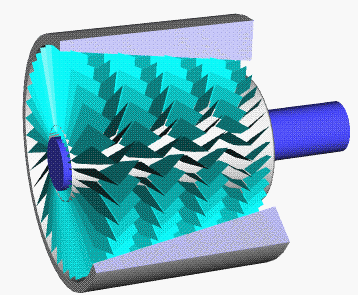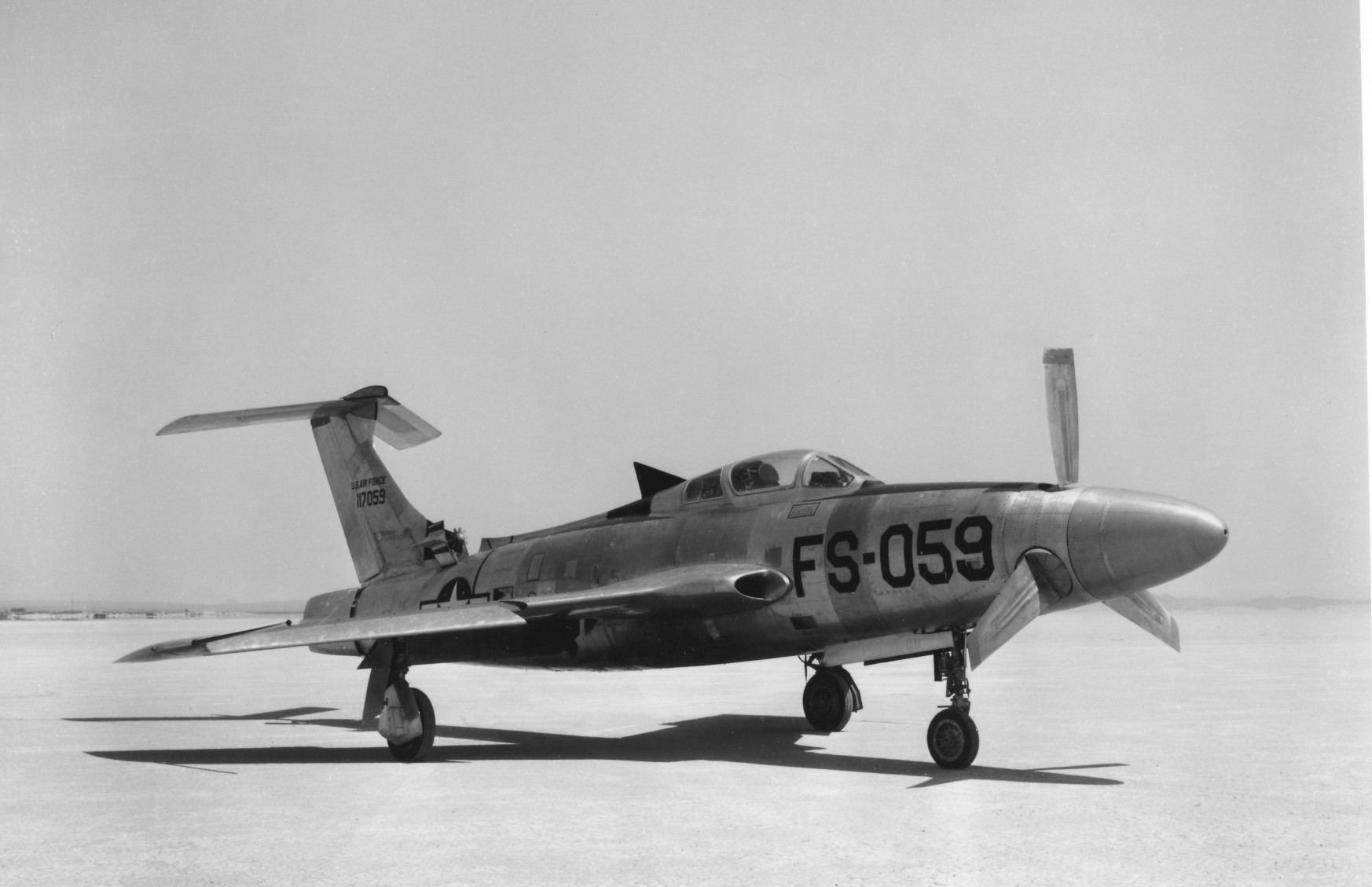|
Republic F-84 Thunderjet
The Republic F-84 Thunderjet is an American turbojet fighter-bomber aircraft. Originating as a 1944 United States Army Air Forces (USAAF) proposal for a "day fighter", the F-84 first flew in 1946. Although it entered service in 1947, the Thunderjet was plagued by such a large amount of structural and engine problems that a 1948 U.S. Air Force review declared it unable to execute any aspect of its intended mission and considered canceling the program. The aircraft was not considered fully operational until the 1949 F-84D model and the design matured only with the definitive F-84G introduced in 1951. In 1954, the straight-wing Thunderjet was joined by the swept-wing F-84F Thunderstreak fighter and RF-84F Thunderflash photo reconnaissance aircraft. The Thunderjet became the USAF's primary strike aircraft during the Korean War, flying 86,408 sorties and destroying 60% of all ground targets in the war as well as eight Soviet-built MiG fighters. Over half of the 7,524 F-84s produced ... [...More Info...] [...Related Items...] OR: [Wikipedia] [Google] [Baidu] |
Fighter-bomber
A fighter-bomber is a fighter aircraft that has been modified, or used primarily, as a light bomber or attack aircraft. It differs from bomber and attack aircraft primarily in its origins, as a fighter that has been adapted into other roles, whereas bombers and attack aircraft are developed specifically for bombing and attack roles. Although still used, the term fighter-bomber has less significance since the introduction of rockets and guided missiles into aerial warfare. Modern aircraft with similar duties are now typically called multirole combat aircraft or strike fighters. Development Prior to World War II, general limitations in available Aircraft engine, engine and Aerospace engineering, aeronautical technology required that each proposed military aircraft have its design tailored to a specific prescribed role. Reciprocating engine, Engine power grew dramatically during the early period of the war, roughly doubling between 1939 and 1943. The Bristol Blenheim, a typical ... [...More Info...] [...Related Items...] OR: [Wikipedia] [Google] [Baidu] |
Inflight Refueling
Aerial refueling (American English, en-us), or aerial refuelling (British English, en-gb), also referred to as air refueling, in-flight refueling (IFR), air-to-air refueling (AAR), and tanking, is the process of transferring aviation fuel from one aircraft (the List of tanker aircraft, tanker) to another (the receiver) while both aircraft are in flight. The two main refueling systems are ''#Probe-and-drogue, probe-and-drogue'', which is simpler to adapt to existing aircraft and the ''#Flying boom, flying boom'', which offers faster fuel transfer, but requires a dedicated Boom operator (military), boom operator station. The procedure allows the receiving aircraft to remain airborne longer, extending its range or Loiter (aeronautics), loiter time. A series of air refuelings can give range limited only by crew Fatigue testing, fatigue/physical needs and engineering factors such as engine oil consumption. Because the receiver aircraft is topped-off with extra fuel in the air, air re ... [...More Info...] [...Related Items...] OR: [Wikipedia] [Google] [Baidu] |
Axial Compressor
An axial compressor is a gas compressor that can continuously pressurize gases. It is a rotating, airfoil-based compressor in which the gas or working fluid principally flows parallel to the axis of rotation, or axially. This differs from other rotating compressors such as centrifugal compressor, axi-centrifugal compressors and mixed-flow compressors where the fluid flow will include a "radial component" through the compressor. The energy level of the fluid increases as it flows through the compressor due to the action of the rotor blades which exert a torque on the fluid. The stationary blades slow the fluid, converting the circumferential component of flow into pressure. Compressors are typically driven by an electric motor or a steam or a gas turbine. Axial flow compressors produce a continuous flow of compressed gas, and have the benefits of high efficiency and large mass flow rate, particularly in relation to their size and cross-section. They do, however, require several ... [...More Info...] [...Related Items...] OR: [Wikipedia] [Google] [Baidu] |
Fuselage
The fuselage (; from the French language, French ''fuselé'' "spindle-shaped") is an aircraft's main body section. It holds Aircrew, crew, passengers, or cargo. In single-engine aircraft, it will usually contain an Aircraft engine, engine as well, although in some amphibious aircraft the single engine is mounted on a hardpoint, pylon attached to the fuselage, which in turn is used as a floating Hull (watercraft), hull. The fuselage also serves to position the Flight control surfaces, control and Stabilizer (aeronautics), stabilization surfaces in specific relationships to Wing, lifting surfaces, which is required for aircraft stability and maneuverability. Types of structures Truss structure This type of structure is still in use in many lightweight aircraft using welding, welded steel tube trusses. A box truss fuselage structure can also be built out of wood—often covered with plywood. Simple box structures may be rounded by the addition of supported lightweight strin ... [...More Info...] [...Related Items...] OR: [Wikipedia] [Google] [Baidu] |
Fighter Aircraft
Fighter aircraft (early on also ''pursuit aircraft'') are military aircraft designed primarily for air-to-air combat. In military conflict, the role of fighter aircraft is to establish air supremacy, air superiority of the battlespace. Domination of the airspace above a battlefield permits bombers and attack aircraft to engage in tactical bombing, tactical and strategic bombing of enemy targets, and helps prevent the enemy from doing the same. The key performance features of a fighter include not only its firepower but also its high speed and maneuverability relative to the target aircraft. The success or failure of a combatant's efforts to gain air superiority hinges on several factors including the skill of its pilots, the tactical soundness of its doctrine for deploying its fighters, and the numbers and performance of those fighters. Many modern fighter aircraft also have secondary capabilities such as ground-attack aircraft, ground attack and some types, such as fighter-b ... [...More Info...] [...Related Items...] OR: [Wikipedia] [Google] [Baidu] |
Republic P-47 Thunderbolt
The Republic P-47 Thunderbolt is a World War II-era fighter aircraft produced by the American company Republic Aviation from 1941 through 1945. It was a successful high-altitude fighter, and it also served as the foremost American fighter-bomber in the ground-attack role. Its primary armament was eight .50-caliber machine guns, and it could carry 5-inch rockets or a bomb load of . When fully loaded, the P-47 weighed up to 8 tons, making it one of the heaviest fighters of the war. The Thunderbolt was effective as a short-, medium-, and long range escort fighter in high-altitude air-to-air combat and ground attack in both the European and Pacific theaters. The P-47 was designed around the powerful Pratt & Whitney R-2800 Double Wasp 18-cylinder radial engine, which also powered two U.S. Navy/U.S. Marine Corps fighters, the Grumman F6F Hellcat and the Vought F4U Corsair. An advanced turbosupercharger system ensured the aircraft's eventual dominance at high altitudes, while al ... [...More Info...] [...Related Items...] OR: [Wikipedia] [Google] [Baidu] |
Alexander Kartveli
Alexander Kartveli, born Aleksandre Kartvelishvili, ( ka, ალექსანდრე ქართველიშვილი; September 9, 1896 – July 20, 1974) was a Georgian aeronautical engineer and an aviation pioneer in the United States. Kartveli achieved important breakthroughs in military aviation in the time of turbojet fighters. (June 30, 2002). Retrieved on October 17, 2011. Education and early career Alexander Kartvelishvili was born in Tbilisi, Georgia, which was part of the Russian Empire at that time; into a noble Georgian family. (Georgians call themselves "kartvelebi", and his surname derives from "Kartveli", or Georgian). He graduated from the grammar school in Tbilisi in 1914. Later on, he decided to move to France, as one of several aviation engineer aspirants of Georgian origin, such as Michael Gregor. Kartvelishvili graduated in 1922 from the Institut supérieur de l'aéronautique et de l'espace in Paris.. He began working as a test pilot but was s ... [...More Info...] [...Related Items...] OR: [Wikipedia] [Google] [Baidu] |
Turboprop
A turboprop is a Gas turbine, gas turbine engine that drives an aircraft Propeller (aeronautics), propeller. A turboprop consists of an intake, reduction drive, reduction gearbox, gas compressor, compressor, combustor, turbine, and a propelling nozzle. Air enters the intake and is compressed by the compressor. Fuel is then added to the compressed air in the combustor, where the Fuel mixture, fuel-air mixture then Combustion, combusts. The hot combustion gases expand through the turbine stages, generating power at the point of exhaust. Some of the power generated by the turbine is used to drive the compressor and electric generator. The gases are then exhausted from the turbine. In contrast to a turbojet or turbofan, the engine's exhaust gases do not provide enough power to create significant thrust, since almost all of the engine's power is used to drive the propeller. Technological aspects Exhaust thrust in a turboprop is sacrificed in favor of shaft power, which is obtaine ... [...More Info...] [...Related Items...] OR: [Wikipedia] [Google] [Baidu] |
XF-84H Thunderscreech
The Republic XF-84H "Thunderscreech" is an American experimental turboprop aircraft derived from the F-84F Thunderstreak. Powered by a turbine engine that was mated to a supersonic propeller, the XF-84H had the potential of setting the unofficial air speed record for propeller-driven aircraft, but was unable to overcome aerodynamic deficiencies and engine reliability problems, resulting in the program's cancellation.Knaack, Marcelle Size. ''Encyclopedia of U.S. Air Force Aircraft and Missile Systems: Volume 1 Post-World War II Fighters 1945–1973''. Washington, D.C.: Office of Air Force History, 1978. . Its name, Thunderscreech, is a reference to its extremely loud supersonic propeller. Design and development Although the USAF Wright Air Development Center was the key sponsor of the Republic Project 3347 turboprop fighter, the initial inception came from a U.S. Navy requirement for a carrier fighter not requiring catapult assistance.Keaveney 1987, p. 9. Originally known as XF ... [...More Info...] [...Related Items...] OR: [Wikipedia] [Google] [Baidu] |
B-36
The Convair B-36 "Peacemaker" is a strategic bomber built by Convair and operated by the United States Air Force (USAF) from 1949 to 1959. The B-36 is the largest mass-produced piston-engined aircraft ever built, although it was exceeded in span and weight by the one-off Hughes H-4 Hercules. It has the longest wingspan of any combat aircraft. The B-36 was capable of intercontinental flight without refueling. Entering service in 1948, the B-36 was the primary nuclear weapons delivery vehicle of Strategic Air Command (SAC) until it was replaced by the jet-powered Boeing B-52 Stratofortress beginning in 1955. All but four aircraft have been scrapped. Development The design of the B-36 can be traced to early 1941, prior to the entry of the United States into World War II. At the time, Britain was at risk of falling to the Nazi "Blitz" attacks, making strategic bombing attacks by the United States Army Air Corps (USAAC) against Germany impossible with the aircraft available.. The ... [...More Info...] [...Related Items...] OR: [Wikipedia] [Google] [Baidu] |
B-29 Superfortress
The Boeing B-29 Superfortress is a retired American four-engined Propeller (aeronautics), propeller-driven heavy bomber, designed by Boeing and flown primarily by the United States during World War II and the Korean War. Named in allusion to its predecessor, the Boeing B-17 Flying Fortress, the Superfortress was designed for high-altitude strategic bomber, strategic bombing, but also excelled in low-altitude night incendiary bombing, and in dropping naval mines to blockade Japan. B-29s dropped the atomic bombings of Hiroshima and Nagasaki, atomic bombs on Hiroshima and Nagasaki, the only aircraft ever to drop nuclear weapons in combat. One of the largest aircraft of World War II, the B-29 was designed with state-of-the-art technology, which included a cabin pressurization, pressurized cabin, dual-wheeled tricycle landing gear, and an analog computer-controlled fire-control system that allowed one gunner and a fire-control officer to direct four remote machine gun turrets. The ... [...More Info...] [...Related Items...] OR: [Wikipedia] [Google] [Baidu] |










